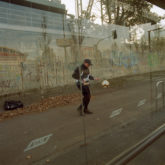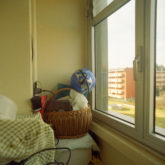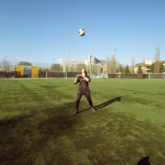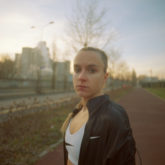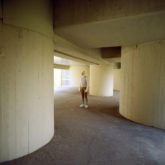C41 & Nike present a true story that shows the future of mixed soccer. Directed by Leone and filmed in the suburbs of Milan by Mauro Chiarello with original soundtrack by MassiveMusic and, of course, the creative direction of c41.eu. The introduction essay is by Moris Gasparri, writer and sport researcher.
Making the news for over a month, like it was something taken for granted.
Presenting yourself to the whole world with heroines like Megan Rapinoe and Alex Morgan, is a great representation of the “sports matriarchy”, never seen before with this intensity.
Shifting the cornerstone of football from “goal” to “platform”, and therefore taking advantage of the playground’s exposure in order to become something more, existence within the society, reference of inclusiveness.
Moving from zero degrees of attention to planetary awareness within a generation is something incredible. Women’s football is a great global revolution, which has its roots in the future, in new endeavours. What is it going to change after the latest summer’s World Cup, the most beautiful and popular of all time? Above all, how will the game itself change in the future? Will it be based on mixed genres? This is the great question that deserves to be examined within the depths of the scenarios that itself evokes.
Female football, in its juvenile perspective, has always had a mixed nature, at least up to the threshold of adolescence. This is held inside its own genetic code, as a sport that has evolved not throughout the transmission between fathers and sons, as it happens with males, but thanks to the bond that link sisters (the youngers) and brothers (the elders).
It may happen that there is a brother to emulate and to follow to the pitch, and maybe, there are his friends to challenge every afternoon after school; this is how many of the champions we admired in France were born. Almost every major player in the game has gone through this phase. For girls, the medley on a football field has always been the real engine for everything, and it is crucial that this confrontation goes on, especially now that the opportunities to play in entirely female teams are increasing. Because facing males players brings even more energy. More hunger, more pressure, more desire. Kick-ups and thirst for affirmation, other kick-ups and desire to be recognized. Because the jeopardy about football played by women has not disappeared yet, despite the great global audience of the World Cup. It is still a game made of elbowing each other on social networks at every given misstep, and it gets even worse if you are a goalkeeper. Many people look at women’s football because of the trend, thinking that it is indeed something that will soon vanish. Actually, this supposed inferiority and the weight of always present judgements can turn into an advantage in the long run. The Hegelian dialectic reminds us that it is the Servant who redeems himself through work, and eventually triumphs.
Sure enough, then things get to the next level. As the age and level rise, biology places an unpassable limit to the practice of mixed football. There is a gap in strength which cannot be zero down, which can become dangerous in tackles, as well as distort the essence of the game itself. Mixing does not erase diversities. It can, and has to, harmonize them, but it cannot suppress them. It is true, more and more Olympic sports are studying mixed formulas, but for team sports it is not a viable way, if not within the futuristic scenarios of the technological transformation of our bodies. Who knows, in the fields of esports, girls and boys could be able to challenge each other together in the new virtual competitions, including the football ones.
It is by widening the perspective that we find other possible forms of mixture. The passion for football does not lay just within big competitions and big stadiums, but also inside a match played between friends right after work. Football between mixed teams will be the next great revolution in costume, and we can already see it today in a lot of its representations. New and unforeseen hierarchies, new mockery, new balances, to eventually become the new ordinary within a few years. It will be the end of the struggle to find the “tenth”.
In order to happen, these transformations require places that are “beyond” by definition: the small playing fields. Since a field unleashes creativity, it is the right place to experiment with new rules, new standards and new combinations. If you think about it, there is an “incredible” footballer, considering what we have been stating so far. She is American, ça va sans dire. Her name is Tobin Heath, she made it to three World Cup finals in a row, and she won the last two. Her hallmark is her dribbling. The special kick originally created by Brazilian black or mulatto footballers in order to dodge contact with whites, found in her the clearest embodiment of women’s football. People call her Tobinho, not by chance. You go right and instead – incredible! – you find yourself on the left. “Queen of nutmeg” is her other nickname. The opponent moves towards you to get your ball and shortly afterwards – incredible! – she is behind him, gone through his body. Her obsession for this is such, that it often leads her not to score in order to always try a new special kick, as it happened in the World Cup final in Lyon against Holland. She said that once she quit with football she would like to teach this inner disposition to the girls: this creative freedom. The one you learn in not-ruled and not rigorously disciplined spaces, in which you have to perform under others’ directions. Spaces of the incredible, and not spaces of the predictable, like those of a playground, which does not have measurable and defined spaces, or rather, it has them, but it is like it does not. Because its geometry is a flexible extension of the dreams. From the small field of Baggio, if you look up, you can see San Siro Stadium.
Credits:
Leone, director
Mauro Chiarello, dp
Igor Ragazzi, editor
c41.eu, creative concept
Luca A. Caizzi, creative director
Alessandro De Agostini, creative producer
K48, production company
Alice Chauvain, executive producer
Marco Agnesi, head of production
Patrizia Gatto, art buyer
Alice De Santis, casting director
Simone Felici, 1st ac
Luce Bertani, 2nd ac
Marco Messina, vtr
Armando Avallone, steadycam operator
Francesco Molaro, sound recordist
Matteo Orsanigo, gaffer
Francesca Pavoni, second unit dp
MassiveMusic, original soundtrack
Thais Montessori Brandao, styling
Yasmin Leite, stylist assistant
Orash Rahnema, color grading
Walter J.Cassetta, strategic planner
Carlo Banfi, art director jr.
Isabella Petricca, art director jr.
Thanks to: Calcetto Eleganza, Baggio Secondo, Ristorante La Barchetta, Google Earth, Vittorio, Mister Luca, Noemi, Sofia, Paola, Matilde, Valentina
